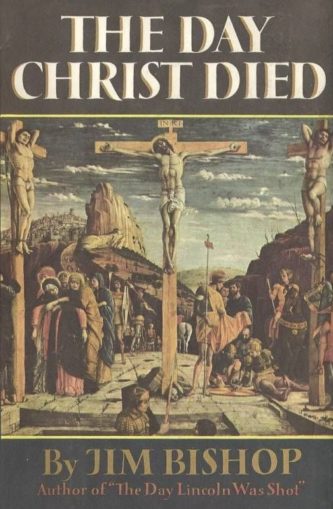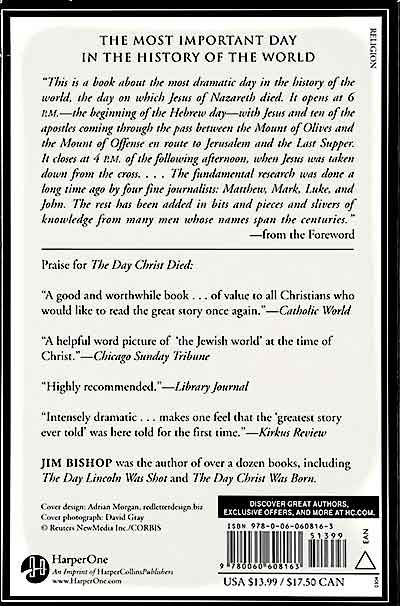 By JIM BISHOP (Perennial Library; 1957/65)
By JIM BISHOP (Perennial Library; 1957/65)
It’s fascinating how much attention so-called Christians devote to the death of Jesus Christ. THE DAY CHRIST DIED, which purports to tell the full, unvarnished story of that “most dramatic day in the history of the world,” stands as a telling example. It includes chapters devoted to describing the Jewish and Roman worlds of Jesus’ time, and also one about J.C.’s life. The latter, however, only runs around 70 pages (in the paperback edition), far less than the meat of the book, which as the title promises is all about Jesus’ final hours.
The late ex-newspaper reporter and literary editor Jim Bishop (1907-1987) all-but specialized in such accounts, including THE DAY LINCOLN WAS SHOT, THE DAY KENNEDY WAS SHOT and THE DAY CHRIST WAS BORN (which of course received far less attention than the present book). That Bishop was a passionate believer is revealed early on in THE DAY CHRIST DIED, and his conviction is evident in the book’s deeply reverent, densely-researched narrative, which (the protracted historical passages aside) makes for a surprisingly satisfying read.
The book begins with the Last Supper, during which Jesus shocks his apostles by revealing that one of them will betray him, and concludes with his defiled corpse taken down from the cross 24 hours later. This follows much horrendous suffering at the hands of sadistic soldiers and the high priests of Jerusalem, who are intent on seeing Jesus executed for his allegedly heretical claims.
Of course, the author can’t help but concede that much of what he relates here makes little logical sense. One example is Pontius Pilate dispatching a coalition of soldiers to arrest Jesus, which Bishop admits would be akin to “sending a major general and two brigades to apprehend a cripple.” Another is the premature night that’s alleged to have overtaken Jerusalem (and indeed the entire world) during the crucifixion, despite which its residents apparently continued their daily activities unabated—leading Bishop to opine that “Apparently the people of Jerusalem were accustomed to sudden changes in the weather.”
The depth of detail Bishop packs into his text is impressive. Jesus’ teachings, for instance, are discussed at some length, thus allowing for an eye-opening demonstration of how far removed those teachings are from those espoused by today’s religious right. Like them, however, Bishop isn’t above cherry-picking what he includes, with Jesus’ oft-quoted proclamation that “it is easier for a camel to go through the eye of needle than for a rich man to enter into the kingdom of God” nowhere to found in these pages.
The minutiae of the crucifixion is certainly discussed in thorough detail, down to the carving of the wooden sign on the cross above Jesus’ head—reading Inri, a.k.a. King of the Jews. Equally detailed are the descriptions of Jesus’ torment and suffering, which would doubtless be called exploitive in any other context. Indeed, THE DAY CHRIST DIED can be viewed as the first splatterpunk text (Jack Ketchum has acknowledged it as an influence on his notorious debut novel OFF SEASON) in its unwavering minute-by-minute focus on pain and bloodletting. Yes, there’s much else to this book, but as in many crucifixion themed narratives (THE PASSION OF THE CHRIST, anyone?) it’s the nastiness that lingers.

